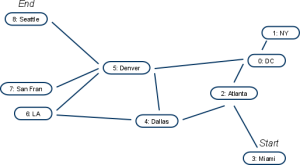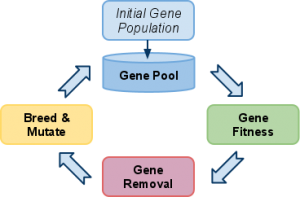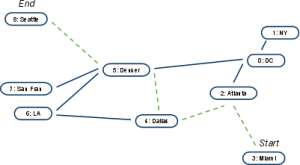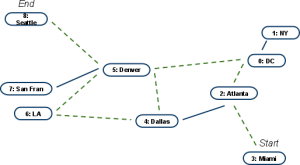Artificially Evolving Intelligence
The Use of Biological Evolution as a Heuristic Method of Computation
The following is from a paper I wrote introducing the reader to genetic algorithms, along with associated ideas in computing such as the difficulty of solving NP-Complete problems. I assume the reader has no background and is written as clearly as possible.
Evolution, a theory explaining how simple biological systems can change into complex systems over time, is a scientific marvel. How could a single cell organism change into the vastly complicated human nervous system? How could we evolve our eyes, even though there are several interdependent structures needed for it to correctly function as a whole? This mystery has been frustrating biologists for centuries until Darwin, in his ground-breaking work “On the Origin of Species”, introduced the theory of evolution. This theory defines a process of small beneficial mutations that propagate to successive generations though natural selection, which may lead to better adaptation for a given environment.
The scientific community now accepts this theory as a valid explanation on the origins of biological systems, yet computer scientists are looking at evolution as a new powerful model of computation (Weise, Zapf, Geihs, 2007). Genetic algorithms, one of the most powerful type of heuristic algorithms, is an application of this theory. The power of genetic algorithms is that it may solve in part, or as a whole, the “Holy Grail” problem of all computer science: Artificial Intelligence (Negnevitsky, 2001). Our own intelligence seems to be out-growing the pace of our biological evolution. Many computer scientists agree that creating artificial human-like intelligence is a critically important topic of our own growing intelligence as a species. The notion that machine-intelligence outperforming human-intelligence is commonly called “the singularity”, with genetic algorithms being key to this event (Kushner, 2008).
Several common problems in computer science are fundamentally hard to solve, and are classified as “NP-complete”. “NP” stands for “nondeterministic polynomial time”, or more simply means that these types of problems have no known reasonably fast algorithmic solution, though testing a solution is easy. Most of these problems are currently solved through “brute-forcing”, which is a method of generating and testing all possible solutions. Even with modern computer hardware, and all of the world’s computers working in unison, it would take thousands or millions of years to solve problems within this classification, even if the input data size was small.
Examples of NP-complete problems include the famous “Travelling salesman problem”, in which a traveling salesman must choose the shortest path from one city to another, using a bus or train route, but knowing not all cities are directly connected (See Figure 1). Though there does not exist any formal solution, humans can easily accomplish this task as we subconsciously compute data in a fundamentally different way than how a computer would. We, as humans, make assumptions left and right until a solution “fits” in our minds for the given problem. We might make several assumptions, and change these assumptions while we solve the problem. Instead of testing all possible solutions, we narrow our solution space more and more until one correct path exists. Subconsciously, many mechanics are going on in our brain that we are not aware of. We might purge data that we do not think is relevant to the problem, as well as zoom in on a specific sub-problem or zoom out to observe the problem as a whole.
Since there is no formal solution to this problem, a computer must brute-force, testing every single possible solution until a correct solution is validated and known to be the shortest path. This is analogous to the computer having to try trillions of paths to find the cheapest path for the travelling salesman, possibly taking thousands of years to complete depending on the size and resolution of the map. To help computers overcome this, a class of algorithms work by trying to mimic what humans do with these kind of difficult problems: divide and conquer data, as well as simple guessing (IEEE, 2000). These are called heuristic algorithms, and like humans, heuristic algorithms are good at finding near-perfect solutions, but not necessarily the single perfect solution.
Figure 1: A sample series of interconnections representing city-to-city access for the United States. Distances can be defined through a table of connections. Note the starting and ending cities, in which the salesman is trying to move from and to as optimally as possible.
Many varying types of heuristic algorithms exist, but most attempt to solve a given problem through human-like methods. Some include “rule-based expert systems”, that follow attempts to make a statistical guess for the answer based on pre-programmed rules from an expert in the associated field. Neural networks, famous in the 1990’s, attempt to mimic basic neuron functionality within brains, but are too simple to represent a complex system, even by the thousands of neurons. Other similar systems exist, but only genetic algorithms have been shown to have special features that make it a powerful approach for difficult computing problems.
Genetic algorithms are named such because it uses the basic principles of evolutionary theory as a way to approach solving a problem. The problem’s solution is represented as a data structure, equivalent to a “gene”. Like a gene, the solution is encoded in a way such that segments may be merged, swapped, mutated, or have other operations applied, but remain mostly valid. Once this gene format is defined, a fitness function must also be defined that returns the correctness of the solution. Two different genes should have different “correctness” values, so that it is possible to quantify if one gene is “better” than another. This concept derives from the evolutionary concept of natural selection of an organism in its environment (Negnevitsky, 2001). If an organism is poorly adapted to its environment, it is said to have low fitness and is more likely to not reproduce. If it is able to survive and reproduce, it is said to have a high fitness, and thus have their good genes propagate.
Once the gene structure and fitness functions are defined, a problem can be solved through a genetic algorithm simulation. A gene pool is created to represents an initial set of possible solutions. Depending on the problem at hand, the pool may start as completely randomized or set to an initial predefined set. Once the gene pool is filled, the simulation starts cycling through fitness measurements, poor-performing gene removal, high-performing gene reproduction, and finally mutations (See Figure 2).
Within this simulation we start by measuring the correctness of each gene, which is equivalent to measuring the correctness of a solution. Once we have all of the correctness values, we then cull the gene pool, which means removing genes from the pool that underperformed. This is up to the simulation’s rules and the associated needs from the problem definition. Sometimes, it is appropriate to remove a certain percentage of genes from the pool, or to remove only those that underperformed compared to a certain value. The initial culling is normally large, but as the genes converge towards a solution, more and more genes are found correct. The remaining genes are then allowed to reproduce, which is done by several methods of data combinatorics. Two or more “parent” genes are merged to create a new set of genes, such that gene segments may be swapped through different methods. Mutations are then introduced, introducing slight changes to allow variance in each potential solution. This is also useful in preventing homogeneous gene pools, which forces the simulation to cycle more often. The simulation is then repeated until a condition is met, defined by the simulation parameters. Most simulations usually end when the top-performing gene meets a certain correctness, defined by the simulation rules. Figure 2 demonstrates the simulation cycle.
Figure 2: This is a generic genetic algorithm simulation cycle, in which an initial pool has a set number of genes, which are then individually measured for correctness. Those that are considered “good” are kept for breeding, while “bad” genes are culled from the pool. Good genes then are reproduced by mixing their contents and have small mutations introduced at a set rate. The simulation is then repeated with the new gene pool.
An applied example of genetic algorithms would be the “Traveling salesman problem”. A “gene” could be a set of adjacent indices to travel through (See Figure 3), and the initial gene pool could be filled with random paths. Gene fitness is simply the measurement of how long the path is from the starting to end positions. Combinations of genes, used for breeding, could be done by swapping chunks of the indices list, making sure to correct any small errors that might occur with new paths. Mutations could occur by introducing slight changes of the index numbers, but only to adjacent nodes to keep the data correct. Over time, a set of genes might emerge as the best possible paths to a target location, in which the simulation may stop if the path is shorter than a certain distance. The system may have to run over hundreds or thousands of simulation cycles, but is heavily dependent on how long the city list is.
Gene 1: City Indices 3, 2, 4, 5, 8
Gene 2: City Indices 3, 2, 0, 5, 4, 6, 5, 8
Figure 3: In this example, a traveling salesman “gene” is represented as a number of indices (cities) to move through, representing a single path a salesman may take. Gene 1 is more correct as it has a shorter distance to travel from the start to end, while the second gene has a longer path by repeating a city. The paths each gene takes is drawn in dashed green lines.
Genetic algorithms have been proven to be useful in real-world applications, from machine-learning applications to robotics systems. MIT has used it for teaching computers to generate original art and music (Sims, 1994), attempting to prove original content can be generated by a machine. Stanford robotics researchers have attempted to solve the complex mechanics needed for bipedal (human-like) walking by creating a virtual world to evolve complex walking machines. A classic programming task for college-level programmers in many universities is to write a genetic algorithm that simulates fish movement to eat a food pellet placed at a random location, thus showing how a program can actually write an entirely new program.
When it comes to more human-like tasks, such as playing a game of battleship (Mysinger, 1998) or drawing the Mona Lisa, genetic algorithms out-perform any pre-programmed method. Though there exists formal algorithms for doing both of these tasks, the difference is that when a human starts playing battleship or drawing for the first time, he or she are clearly not experts in the field, much like how genetic algorithms only know the very basics of the problem. It is up to the human and genetic algorithm, over time, to learn strategies for ship placement and brush strokes, making this type of heuristic algorithm extremely unique. The power here is the ability to learn and adapt over time, based on the more experience the simulation is given. These samples have also become so common to find on the internet, any modern browser, through a quick Google search of “javascript genetic algorithms examples”, can run sample applications of genetic algorithms.
One of the largest criticisms of genetic algorithms is that they fundamentally have large computational needs, which is only subtly different from brute-forcing a solution. Unlike a formal algorithm, the termination of a genetic algorithm simulation is informal, and simulation times may vary dramatically, even for the same problem. Genetic algorithms are also only guaranteed to find near-perfect solutions; they are usually never used to find perfect solutions because it is rare to find even with large simulation times. Genetic algorithms are also commonly used for “prototyping” a solution, showing that one may actually exist for a given problem without having to write and prove a formal algorithm. Though they are not good for any real-time applications, it is currently a powerful tool in pre-processing data and finding solutions on massive multi-processor computers. Genetic algorithms have the benefit of being easily split between processors, increasing the simulation speed in relation to the number of parallel processor. As the consumer PC market changes, it is expected most standard computers will have more and more multi-core processors, making it a perfect environment to quickly run genetic algorithms.
Another complaint of genetic algorithms is that they may sometimes be locally correct, but not globally correct, and thus “freeze” the simulation to a wrong local optima. This means that a generated solution might work well for a part of the problem, but not for the entire problem. Since the genetic algorithm simulation doesn’t know any better, it continues to evolve only to that sub-problem. This can be solved by increase the rate of mutations, which might “dislodge” a local optima into a globally correct solution, but adds extra simulation time. This is a critical problem, which is why genetic algorithms may need “oversight” from other types of algorithms.
The use of genetic algorithms is both a valid approach to many complex problems, such as the NP-Complete class of computing problems, and as an effective way of learning for a computer. Though this type of algorithm has several weaknesses, much like many other heuristic algorithms, it has been shown to be a powerful tool in the quest to solve the problem of Artificial Intelligence. Current researches are mixing several different types of heuristic algorithms in attempt to develop true AI. One of the current largest application is with autonomous vehicles: cars that drive themselves. DARPA, the United States Government’s research group, is funding projects in which university teams are teaching cars how to drive themselves. This is done by manually driving vehicles hundreds of hours, showing an on-board genetic algorithm how it should be driving, rather than programming it manually (IEEE, 2000). Once the system has learned enough, it is able to drive the vehicle fully autonomously, without a human in the driver’s seat. Other major research applications focus on voice recognition software, commonly used for the disabled and handicapped. Many robotics systems in industrial manufacturing are now able to better adapt at run-time, building more complex and dynamic structures. Many storage facilities have also become completely autonomous, retrieving items from distant corners of the warehouse with a click of a button. With all of these advancements, we are very close to seeing true AI, and genetic algorithms are leading the way. The “singularity” of machine-intelligence outperforming human-intelligence is nearer each day (Haugeland, 1997).
Genetic algorithms may lead a revolution in the near future as processor manufacturers are focusing on highly multi-core processors for the consumer market. Genetic algorithms can take advantage of this more than other types of heuristic algorithms, as it is very multi-processing friendly, giving it a huge performance increase. With this added power, genetic algorithms are shown to have successful applications in intelligent systems, from autonomous vehicles (IEEE 2000) to computer-generated art (Sims 2010). Researchers in the field of Artificial Intelligence have been trying to model what intelligence is at its core (Haugeland 1997), which if it is a quantifiable structure, can be simulated by genetic algorithms. Ultimately, this may lead to the generation of true Artificial Intelligence. Darwin knew of the revolution his radical theory would introduce into the world of biology, but he might of never known how far reaching his theory’s implications were, and how it could lead into the development of Artificial Intelligence for modern applications.
References
IEEE Intelligent Systems staff. “Genetic Programming”. IEEE Intelligent Systems, vol. 15 n. 3, pp.74-84, May 2000.
Kushner, David. “Two AI Pioneers. Two Bizarre Suicides. What Really Happened?” Wired News. 18 Jan. 2008. Web. 27 Apr. 2010. <http://www.wired.com/techbiz/people/magazine/16-02/ff_aimystery>.
Haugeland, John. Mind Design II: Philosophy, Psychology, Artificial Intelligence. Cambridge, Mass.: MIT, 1997. Print.
Sims, Karl. “Evolved Virtual Creatures.” 1994. Web. 03 May 2010. <http://www.karlsims.com/evolved-virtual-creatures.html>.
Negnevitsky, Michael. Artificial Intelligence: a Guide to Intelligent Systems. Harlow: Pearson, 2001. Print.
M. Mysinger, “Genetic Design of an Artificial Intelligence to Play the Classic Game of Battleship”. Genetic algorithms and genetic programming and Stanford, pp. 101-110. 1998.
T. Weise; M. Zapf; K. Geihs, “Rule-based Genetic Programming”. Bio-Inspired Models of Network, Information and Computer Systems, pp. 8- 15, Dec. 2007.




One Response to Artificially Evolving Intelligence